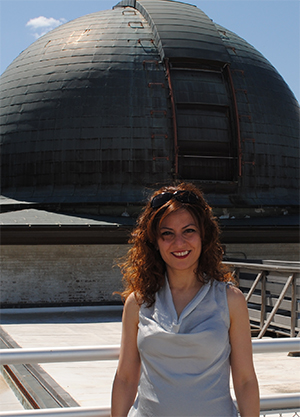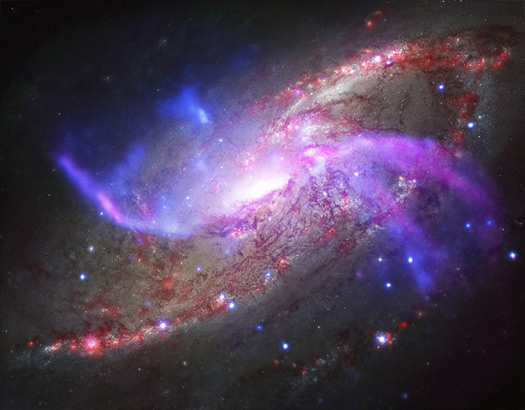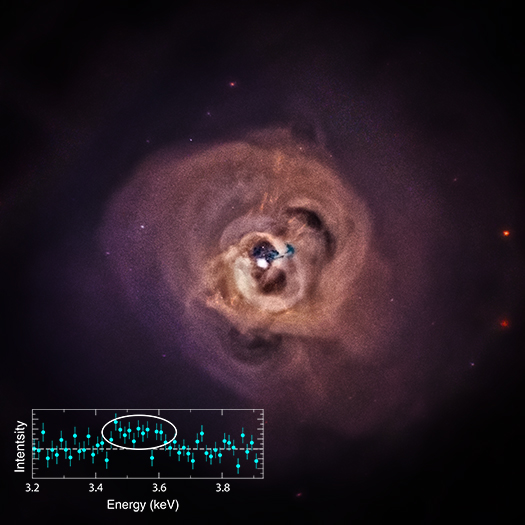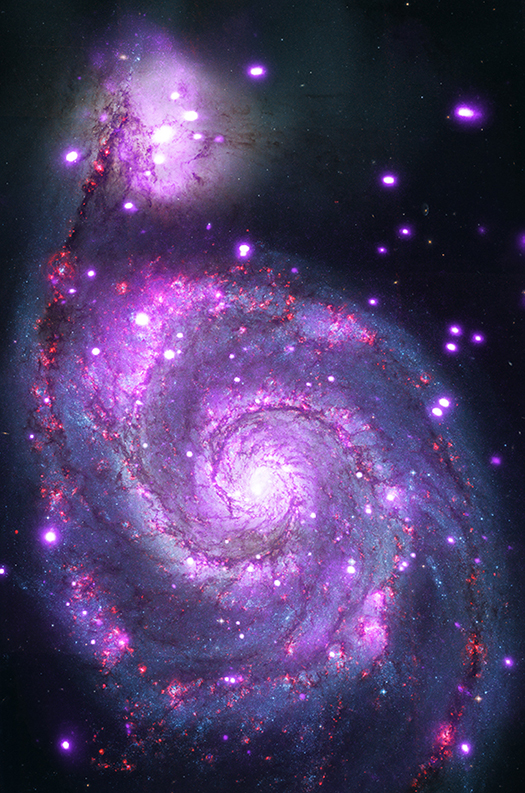Nanda Rea Wins Award for Solving a Magnetic Mystery
Submitted by chandra on Tue, 2014-07-01 10:45
Nanda Rea. Credit: N. Rea
Last week, the Committee on Space Research (COSPAR) announced the awards that will be presented at their upcoming meeting in August in Moscow. One of the winners of the Yakov B. Zeldovich Medals -- a joint award of COSPAR and the Russian Academy of Sciences conferred on young scientists for excellence and achievements – will go to Nanda Rea.
Dr. Rea is an assistant professor at the Institute of Space Sciences (CSIC-IEEC) in Barcelona and the Anton Pannekoek Institute (API) at the University of Amsterdam. She has spent much of her career studying magnetars, a special class of neutron stars that have some of the strongest magnetic fields in the Universe.
A Flash in the Dark!
Submitted by chandra on Mon, 2014-06-23 13:44
We are delighted to welcome Esra Bulbul as a guest blogger. Esra led the new study reporting evidence for a mysterious X-ray signal in galaxy clusters, leading to our latest press release. She earned her master’s degree in physics from the Middle East Technical University in the capital city, Ankara, in Turkey in 2006. Four years later she graduated with a PhD in physics from the University of Alabama in Huntsville / NASA Marshall Space Flight Center. After receiving her Ph.D. she moved to the Harvard-Smithsonian Center for Astrophysics as a Smithsonian Astrophysical Fellow working jointly at the NASA Goddard Space Flight Center as a visiting scientist. She is now back at the Harvard-Smithsonian Center for Astrophysics and enjoys living in the greater Boston area.
When I started my first postdoc at the Harvard-Smithsonian Center for Astrophysics, I already knew that one alternative way to improve the sensitivity of current instruments like Chandra and XMM-Newton is to “stack” large numbers of observations of galaxy clusters, meaning that we layer one observation on top of another.
The great advantage of stacking observations is not only an increased signal-to-noise ratio (that is, the amount of useful signal compared to background noise), but also the diminished effects of detector and background features. The X-ray background emission and instrumental noise are the main obstacles in the analysis of faint objects, such as galaxy clusters.
Mysterious X-ray Signal Intrigues Astronomers
Submitted by chandra on Mon, 2014-06-23 13:36A new study of the Perseus galaxy cluster, shown in this image, using NASA's Chandra X-ray Observatory and 73 other clusters with ESA's XMM-Newton has revealed a mysterious X-ray signal in the data. This signal is represented in the circled data points in the inset, which is a plot of X-ray intensity as a function of X-ray energy. The signal is also seen in over 70 other galaxy clusters using XMM-Newton. This unidentified X-ray emission line - that is, a spike of intensity at a very specific energy, in this case centered on about 3.56 kiloelectron volts (keV) - requires further investigation to confirm both the signal's existence and nature as described in the latest Chandra press release.
Visualizing the X-ray Universe: Stories About Science
Submitted by chandra on Tue, 2014-06-17 10:34Telling a story about science can come in many different shapes, from an image of the area around a black hole, to a three-dimensional model of the remains of an exploded star, to something as simple as a tweet about a planet. Working for the Chandra X-ray Observatory, one of NASA's “Great Observatories” that studies extremely hot regions in space such as colliding galaxies and neutron stars, there is no shortage of data to tell stories about. Chandra orbits about 1/3 of the way to the Moon so it can take long exposures of cosmic objects. This year, Chandra marks its 15th anniversary of science operations out in the cold, dark and somewhat dangerous void of space.
Perhaps 50% of the job of “visualizing the X-ray Universe” is figuring out how we need to look at Chandra’s X-ray data and asking ourselves: what questions are this data trying to answer? what do experts see in this data? how will non-experts view and understand the data? The remaining 50% of the job is then what to do with that data, to make it both accessible and understandable.

Chandra Captures Galaxy Sparkling in X-rays
Submitted by chandra on Tue, 2014-06-03 10:30Nearly a million seconds of observing time with NASA's Chandra X-ray Observatory has revealed a spiral galaxy similar to the Milky Way glittering with hundreds of X-ray points of light.
The galaxy is officially named Messier 51 (M51) or NGC 5194, but often goes by its nickname of the "Whirlpool Galaxy." Like the Milky Way, the Whirlpool is a spiral galaxy with spectacular arms of stars and dust. M51 is located about 30 million light years from Earth, and its face-on orientation to Earth gives us a perspective that we can never get of our own spiral galactic home.
Chandra Helps Explain "Red and Dead Galaxies"
Submitted by chandra on Fri, 2014-05-30 09:13NASA's Chandra X-ray Observatory has shed new light on the mystery of why giant elliptical galaxies have few, if any, young stars. This new evidence highlights the important role that supermassive black holes play in the evolution of their host galaxies.
Because star-forming activity in many giant elliptical galaxies has shut down to very low levels, these galaxies mostly house long-lived stars with low masses and red optical colors. Astronomers have therefore called these galaxies "red and dead".
Chandra and the Camelopardalids
Submitted by chandra on Thu, 2014-05-22 08:35Update (05.28.14): According to the team at the OCC, Chandra was unharmed during this new meteor shower. They report that passage through the stream was 'thankfully unremarkable.' According to all of their information, there was no evidence for any type of impact and it was 'smooth sailing.'
This week, sky watchers will be treated to a special event: a new meteor shower. Meteor showers occur when Earth, on its orbit around the Sun, passes through the debris left behind by a comet. There are some debris fields that Earth passes through every year and produce regular meteor showers that many people have heard of. These include the Leonids in November and the Perseids in July and August.
Chandra "Enthusiastically Endorsed" for Extension in Senior Review
Submitted by chandra on Tue, 2014-05-20 10:45Peter Edmonds is the Chandra Press Scientist and, in addition to his work on publicizing Chandra science, has been heavily involved with the Chandra's Senior Review proposal since 2008.
In science, "peer review" is used to describe a process that determines whether a research paper should be published in a journal. One or more experts review the paper and determine its fate: are the results and discussion reliable and do they meet the publication standards of the journal?
Core-Halo Age Gradients in Young Stellar Clusters
Submitted by chandra on Wed, 2014-05-07 09:55We are delighted to welcome a trio of guest bloggers to discuss their work related to the newest Chandra press release on star clusters and star formation. Konstantin Getman, Eric Feigelson, and Michael Kuhn are colleagues at Penn State University and are all involved in the Massive Young Star-Forming Complex Study in Infrared and X-ray (MYStIX) project led from that institution.

Figure 1: From left to right, Michael Kuhn, Eric Feigelson, and Konstantin Getman.
Pages
Please note this is a moderated blog. No pornography, spam, profanity or discriminatory remarks are allowed. No personal attacks are allowed. Users should stay on topic to keep it relevant for the readers.
Read the privacy statement







